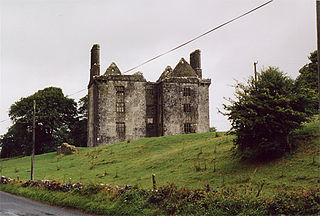Related Research Articles

There have been five baronetcies created for persons with the surname Barker, three in the Baronetage of England, one in the Baronetage of Great Britain and one in the Baronetage of the United Kingdom. All five creations are extinct.
There have been four baronetcies created for persons with the surname Leslie, one in the Baronetage of Nova Scotia, one in the Baronetage of Ireland, one in the Baronetage of Great Britain and one in the Baronetage of the United Kingdom. Three of the creations are extant as of 2010.

There have been two baronetcies created for persons with the surname Burke, both in the Baronetage of Ireland. As of 2014 one creation is extant.
Sir John Houstoun of that Ilk, 2nd Baronet was a member of the Parliament of Scotland for Renfrewshire from 1685 to 1686 and 1702 to 1707 and for Stirlingshire in 1689 then from 1689 to 1702.
Sir Alexander Home of Renton, 1st Baronet was created a Baronet of Nova Scotia about 1678. He was also knighted sometime before 28 August 1671 when he was described as such in a Laing charter.
There have been five baronetcies created for persons with the surname Vavasour, three in the Baronetage of England and two in the Baronetage of the United Kingdom. As of 2008 four of the creations are extinct while one is extant.
There have been three baronetcies created for persons with the surname Bellingham, one in the Baronetage of England, one in the Baronetage of Ireland and one in the Baronetage of Great Britain. As of 2014 one creation is extant.

There have been twenty one baronetcies created for persons with the surname Williams, eight in the Baronetage of England, three in the Baronetage of Great Britain and ten in the Baronetage of the United Kingdom. Only six of the creations are extant as of 2017.

There have been four baronetcies created for persons with the surname Hope, three in the Baronetage of Nova Scotia and one in the Baronetage of the United Kingdom. As of 2010 one creation is extant, one dormant and two extinct.

There have been eight baronetcies created for persons with the surname Wilson, one in the Baronetage of Ireland and six in the Baronetage of the United Kingdom.
There have been seven baronetcies created for persons with the surname Lawrence, one in the Baronetage of England, one in the Baronetage of Great Britain and five in the Baronetage of the United Kingdom.
There have been two Cockburn baronetcies in the Baronetage of Nova Scotia.
There have been four baronetcies created for persons with the surname Hay, all in the Baronetage of Nova Scotia. Two creations are extinct, one dormant and one extant. A fifth baronetcy in the Jacobite Peerage, although theoretically extant, is not recognised by the Lyon Office.
There have been four baronetcies created for persons with the surname Seton, all in the Baronetage of Nova Scotia. As of 2008 one creation is extant, one dormant and two extinct.
There have been five baronetcies created for persons with the surname Home, four in the Baronetage of Nova Scotia and one in the Baronetage of the United Kingdom. Only one creation is extant as of 2008.
The Blackwell Baronetcy, of Sprowston in the County of Norfolk, was a title in the Baronetage of Great Britain.

The Lawrencebaronetcy, of Loseby in the County of Leicester, was a title in the Baronetage of Great Britain. It was created on 17 January 1748 for Edward Lawrence, Esq., with remainder to his great-nephew, Isaac Woollaston of Lowesby Hall, Leicestershire. Lawrence was MP for Stockbridge. He died in 1749 and was succeeded according to the special remainder by his great-nephew, Isaac Woollaston, the second baronet. He was the grandson of Josiah Woollaston (1652–1689) by his wife Elizabeth Lawrence, sister of the first baronet. The title became extinct on the death of the second baronet's son, the third baronet, who died as a child in 1756.

There have been three baronetcies created for persons with the surname Turner, all in the Baronetage of Great Britain, one of which became extinct after two holders, one after three and one of which is extant however became renamed in 1766 to match the new successor's new surname Page-Turner and subsequently devolved to the Dryden baronets.
The Dick baronetcy in Prestonfield, Edinburgh was created in the Baronetage of Nova Scotia for James Dick. Initially created in 1677, it was renewed in 1707 and merged with the Cunningham of Lambrughton, Ayrshire baronetcy in 1829. The family seat was Prestonfield House, Edinburgh. Sir William Dick, 2nd Baronet and Sir Alexander Dick, 3rd Baronet were the younger sons of Sir William Cunningham, 2nd Baronet and his wife Janet Dick, the daughter and heiress of Sir James Dick, 1st Baronet. Both brothers changed their surname to Dick on inheriting Prestonfield in turn.
There have been three baronetcies created for people with the surname Moncreiffe or Moncreiff, two in the Baronetage of Nova Scotia and one in the Baronetage of the United Kingdom. Two of the titles are dormant, as the heir has not proved his descent, and one is extant, though its holder does not bear the surname of Moncreiffe.
References
- ↑ John Burke, Bernard Burke, 'Dalmahoy of that Ilk' in A Genealogical and Heraldic History of the Extinct and Dormant Baronetcies of England, Ireland and Scotland (1844), p.619.